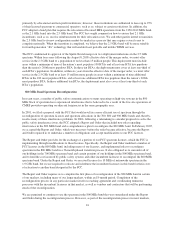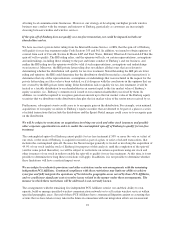Sprint - Nextel 2005 Annual Report Download - page 36
Download and view the complete annual report
Please find page 36 of the 2005 Sprint - Nextel annual report below. You can navigate through the pages in the report by either clicking on the pages listed below, or by using the keyword search tool below to find specific information within the annual report.• obtain adequate quantities of system infrastructure equipment and handsets, and related accessories to
meet subscriber demand.
Network enhancements may not occur as scheduled or at the cost that we have estimated. Delays or failure to add
network capacity, or increased costs of adding capacity, could limit our ability to satisfy our wireless subscribers,
resulting in decreased revenues. Even if we continuously upgrade our wireless networks, there can be no
assurance that existing subscribers will not prefer features of our competitors and switch wireless providers.
Consolidation and competition in the wholesale market for wireline services could adversely affect our
revenues and profitability.
Our Long Distance segment competes with AT&T (formerly known as SBC Communications, which recently
acquired AT&T), Verizon Communications (which recently acquired MCI), BellSouth Corporation, Qwest
Communications, Level 3 Communications, Inc., and cable operators, as well as a host of smaller competitors, in
the provision of wireline services. Some of these companies have built high-capacity, IP-based fiber-optic
networks capable of supporting large amounts of voice and data traffic. These companies claim certain cost
structure advantages which, among other factors, may allow them to maintain profitability while offering
services at a price below that which we can offer profitably. Increased competition and the significant increase in
capacity resulting from new technologies and networks may drive already low prices down further. Both AT&T
and Verizon, as a result of their recent acquisitions, continue to be our two largest competitors in the domestic
long distance communications market. We and other long distance carriers depend heavily on local access
facilities obtained from ILECs to serve our long distance customers, and payments to ILECs for these facilities is
a significant cost of service for our Long Distance segment. The acquisition of AT&T by SBC and MCI by
Verizon could give those carriers’ long distance operations cost and operational advantages with respect to these
access facilities because those carriers serve significant geographic areas, including many large urban areas, as
the incumbent local carrier.
In urban areas where Embarq operates, there is substantial competition from CLECs and cable operators, and
competition is increasing in the suburban and rural areas that it serves. Cable companies selling cable modems
continue to provide competition for high-speed data services to residential customers in Embarq’s service areas
and are beginning to offer voice telephone service using their cable facilities in those areas. Competition from
wireless services also affects Embarq, as e-mail and wireless services continue to grow as an alternative to the
wireline services we offer.
Failure to complete development, testing and deployment of new technology that supports new services
could affect our ability to compete in the industry and the technology we use places us at a competitive
disadvantage.
We develop, test and deploy various new technologies and support systems intended both to enhance our
competitiveness by supporting new services and features and reducing the costs associated with providing those
services. Successful development and implementation of technology upgrades depend, in part, on the willingness
of third parties to develop new applications in a timely manner. We may not successfully complete the
development and rollout of new technology and related features or services in a timely manner, and they may not
be widely accepted by our customers or may not be profitable, in which case we could not recover our
investment in the technology. Deployment of technology supporting new service offerings may also adversely
affect the performance or reliability of our networks with respect to both the new and existing services. Any
resulting customer dissatisfaction could affect our ability to retain customers and have an adverse effect on our
results of operations and growth prospects.
Our wireless networks provide services utilizing CDMA and iDEN technologies. Wireless subscribers served by
these two technologies represent a smaller portion of global wireless subscribers than the subscribers served by
wireless networks that utilize GSM technology. As a result, our costs with respect to both CDMA and iDEN
network equipment and handsets are generally higher than the comparable costs incurred by our competitors who
use GSM technology.
25
























